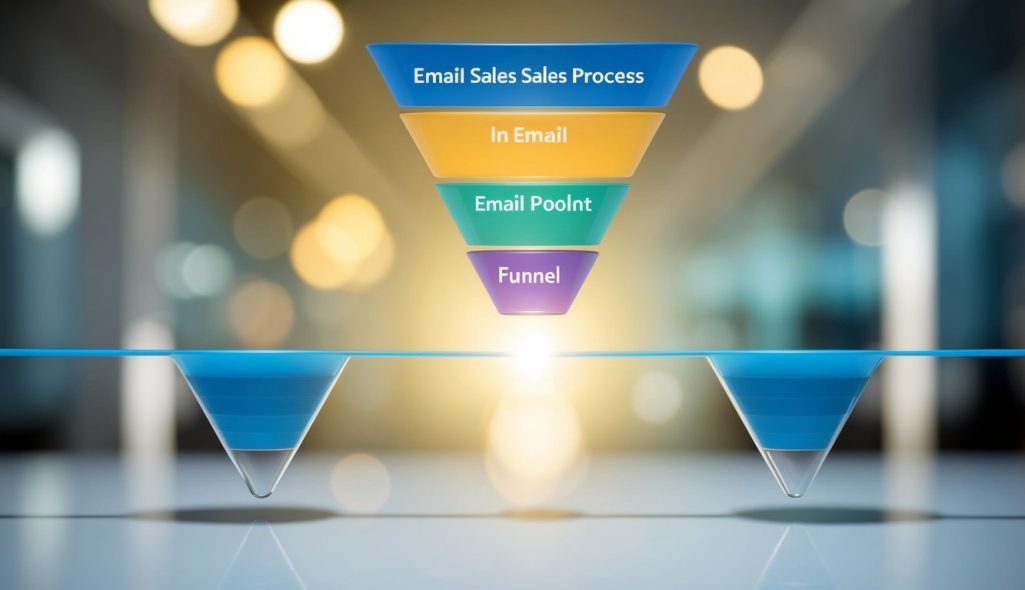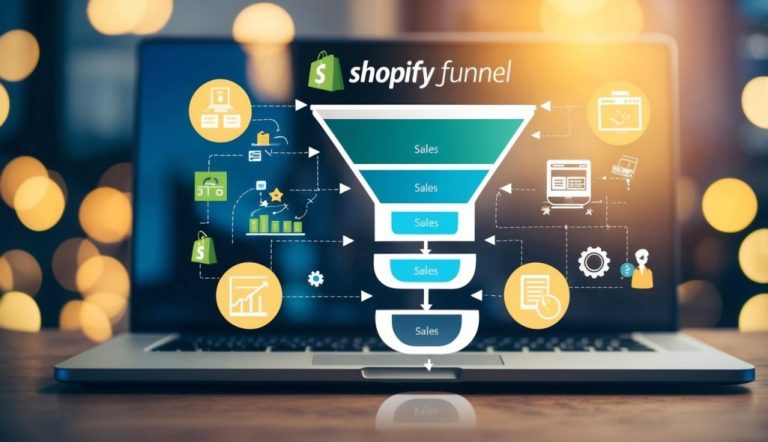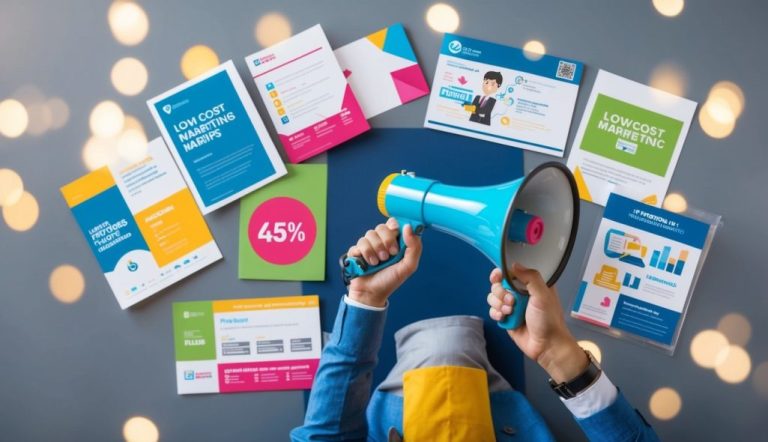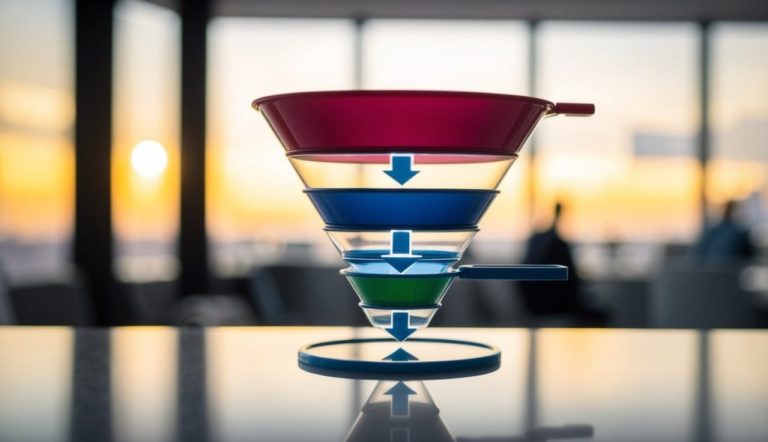Email sales funnels guide potential customers through each stage of their buying journey. They send out a series of targeted emails that encourage engagement and eventual conversions.
An email sales funnel helps you turn interested subscribers into paying customers. You do this by nurturing them with relevant content and timely offers. Understanding how to effectively create and use these funnels can significantly improve your sales and marketing efforts.

To start building an effective email sales funnel, you need to collect email addresses and grow your list. This initial step sets the foundation for engaging and nurturing your potential customers.
The key to success lies in designing email campaigns that capture attention and move subscribers smoothly through the funnel stages. By doing so, you increase the chances of converting these leads into loyal customers.
Incorporating automation into your strategy makes managing email sales funnels more efficient and impactful. Automation allows you to send personalized emails at just the right moment, ensuring your message is both timely and relevant. This not only enhances customer experience but also maximizes your sales and revenue potential.
Key Takeaways
- Email sales funnels nurture subscribers into paying customers.
- Automation personalizes and streamlines email campaigns.
- A well-crafted funnel boosts sales and customer loyalty.
Understanding Email Sales Funnels
Email sales funnels are essential tools for guiding potential customers through the stages of the buying process. They help businesses nurture leads and convert them into paying customers by automating communication tailored to each stage of the funnel. This process enhances awareness, consideration, and engages leads at the crucial conversion stage.
Defining the Email Sales Funnel
An email sales funnel is a strategic sequence of emails designed to take prospects from the initial awareness stage to the conversion stage. In the awareness stage, potential customers first learn about your brand or product. This could be through signing up for a newsletter or responding to an ad. As they receive more targeted information, they move into the consideration stage.
Here, they start evaluating how your offerings meet their needs. The ultimate goal is to guide them through each stage until they reach the conversion stage, which is when they decide to make a purchase. This step-by-step approach allows you to engage with leads in a structured way, ensuring that each email adds value and persuades them to take action.
The Importance of Email in Sales Conversion
Emails are vital for driving sales conversion. They enable businesses to communicate directly with potential customers at the right time with the right message. During the consideration stage, informative emails help address any questions or objections prospects might have. Offering incentives like discounts or exclusive deals in emails can also encourage conversions.
Moreover, personalization is key. Tailored content that addresses the specific interests or pain points of your audience fosters a sense of connection. Emails can showcase how your product fulfills their needs, making the decision-making process easier. By automating these communications, you save time and resources while maintaining a personalized touch, significantly improving conversion rates.
Crafting Your Email Marketing Strategy
Effective email marketing requires a well-thought-out strategy that guides your audience through each stage of the buyer’s journey. By setting clear objectives, understanding your target audience, and choosing tailored content, you can build a successful email marketing funnel.
Setting Clear Goals and Objectives
Define what you want to achieve with your email marketing. Start with specific, measurable goals that align with your overall marketing strategy. This might include increasing sales, growing your subscriber list, or enhancing customer engagement.
Consider which stage of the funnel you want to target. For example, in the awareness stage, your goal could be to introduce your brand to new subscribers. For the engagement stage, you might focus on nurturing relationships with informative content. Clear objectives provide direction for your campaigns and help you measure success.
Segmenting Your Target Audience
To effectively reach different subscriber groups, segment your target audience. Break down your list based on behaviors, demographics, or purchase history. This allows you to tailor messages to meet specific needs and preferences.
For instance, a segment of new leads might receive welcome emails to guide them through the consideration stage. A different segment, such as loyal customers, could receive exclusive offers to boost retention. Segmentation ensures that your emails are relevant and personalized, increasing open and click-through rates.
Choosing the Right Content for Each Stage
Craft content that resonates with your audience at every stage of the funnel. In the awareness stage, focus on educational content that introduces your brand, such as blog links or industry insights.
During the consideration stage, provide content that helps prospects evaluate their options, like product comparisons or demo videos. For the engagement stage, build trust with customer stories or testimonials. In the retention stage, offer loyalty rewards or personalized recommendations to maintain interest.
Carefully selecting content ensures it meets the needs of your subscribers, guiding them smoothly through the buyer’s journey.
Building Your Email List
Growing your email list involves creating methods for capturing leads and offering valuable incentives to encourage sign-ups. The key steps include designing opt-in forms that attract attention and providing high-value lead magnets to entice potential subscribers.
Creating Effective Opt-In Forms
Opt-in forms are a crucial tool for capturing leads. To make them effective, you should focus on visually appealing designs and clear calls to action. Placing these forms in prominent locations on your website, such as the home page, blog posts, or landing pages, can significantly increase sign-ups.
Using a simple and concise wording encourages visitors to join your email list. It’s essential to reassure them about the privacy of their information. You can also conduct A/B testing to find which designs and messages perform best. Remember, the goal is to make signing up an easy and attractive choice for visitors.
Offering High-Value Lead Magnets
Lead magnets are incentives offered in exchange for an email address. High-value lead magnets, like ebooks, discount codes, or exclusive content, provide visitors with meaningful benefits, making them more likely to join your list. For example, offering a “10% discount” on the first purchase is a popular and effective magnet.
Creating content that aligns with your audience’s interests and needs is crucial. Tailor your lead magnets to solve a problem or offer a significant benefit. This shows the value of being part of your email list and encourages more people to sign up. Clearly communicate this value in your opt-in forms to improve sign-up rates.
Designing Engaging Email Campaigns
To create successful email campaigns, focus on three key elements: crafting welcome emails that captivate, developing educational content to nurture leads, and using personalized emails to boost engagement. Each step plays a crucial role in creating a connection with your audience.
Crafting Welcome Emails That Hook
Welcome emails set the tone for your relationship with subscribers. These initial messages are your chance to make a great first impression. Start with a friendly greeting and thank them for joining your list.
Offer something valuable, like a discount or a free resource, to immediately engage them. Make your email visually appealing by using your brand’s colors and logos. Short paragraphs, bullet points, and bold headlines enhance readability. Including a clear call-to-action (CTA) encourages the next step, such as exploring your website or following you on social media.
Developing Educational Content for Nurture Leads
Educational content is vital for nurturing leads through email. By offering informative and useful content, you help build trust and establish authority. Use a series of emails to share insights related to your products or industry.
Tips, tutorials, and guides are excellent formats for this purpose. These emails should encourage your subscribers to view your brand as a valuable resource. Keep the language simple and use visuals, like infographics or videos, to clarify complex topics. Match the content to the subscriber’s stage in the buying process, gradually guiding them towards making a purchase.
Utilizing Personalized Emails for Engagement
Personalized emails significantly enhance customer engagement. Tailor your messages based on subscriber behavior and preferences. Start by addressing the recipient by their name to create a more personal connection.
Segment your audience to send targeted content that aligns with their interests. You might recommend products similar to past purchases or suggest content that complements what they’ve shown interest in. Behavioral triggers, like sending an email after a cart abandonment, can re-engage potential customers. Use dynamic content to keep emails relevant and compelling, making subscribers more likely to interact and respond positively to your campaigns.
Enhancing With Email Marketing Automation
Email marketing automation transforms your engagement strategy by creating structured systems for consistent communication. It allows you to efficiently manage tasks like sending out emails at the right times, optimizing your workflow, and gaining insights into performance through analytics. This approach helps you keep in touch with your contacts, improving both relationships and conversion rates.
Setting Up Email Sequences
An effective email sequence is crucial for nurturing leads. Begin by defining what each email should achieve, whether it’s welcoming a new subscriber or encouraging a purchase. Use automation tools to schedule emails based on subscriber actions or time intervals. This structured approach guides recipients through your sales funnel, ensuring they receive relevant information at the right moments.
Developing sequences that respond to user behavior makes the communication feel personalized. This could involve segmenting your audience based on demographics or past interactions. Making adjustments based on what you see working will help you refine your sequences over time.
Using Analytics to Optimize Performance
Analytics play a vital role in understanding the success of your email marketing campaigns. They help you track key metrics like open rates, click-through rates, and conversions. This data allows you to see what resonates with your audience and where there’s room for improvement.
Identifying patterns or trends can lead to actionable insights. For instance, if you notice a high unsubscribe rate after a particular email, it may require revising. By consistently evaluating these analytics, you can adjust your strategies to better meet your audience’s interests and needs.
Automating for Efficiency and Consistency
Automation helps streamline your email marketing efforts by reducing manual tasks, freeing up resources for creative work. Setting up triggers based on user interactions, such as clicks or purchases, ensures timely responses without constant oversight.
This consistency builds trust, as recipients can expect timely and relevant communication. Automation also helps maintain a steady flow of communication across different platforms. By automating routine tasks, you ensure every subscriber gets attention while focusing on more strategic elements of your campaigns. For more, consider reading about how to use automation to optimize your marketing.
Optimizing for Conversion
Effective email sales funnels require careful attention to conversion. By testing, designing, and crafting strategic elements, you can enhance how your audience interacts with your campaign. These tactics help improve conversion rates and maximize the effectiveness of your funnel.
Testing with A/B Experiments
A/B testing is crucial for understanding what works best in your email campaigns. By splitting your audience into two groups, you can test variables like subject lines or send times. This helps identify which version leads to higher open and conversion rates. Regularly conducting these tests provides data-driven insights. It’s important to only change one element at a time to see clear results. Tracking metrics such as click-through rates will also aid in refining your approach.
Creating Conversion-Driven Landing Pages
Landing pages linked in your emails play a vital role in conversion. It’s essential that they are designed to be clear and focused on a single call-to-action. Avoid clutter and make sure key information is easily accessible. Using bullet points can enhance readability. Incorporate trust signals like customer testimonials to boost credibility. The goal is to ensure every element on the page supports the intended action, whether it’s making a purchase or signing up for a newsletter.
Crafting Targeted Conversion Emails
Craft emails that speak directly to the needs and interests of your audience. Personalization is key to improving engagement and conversion rates. Use tools that segment your audience based on previous interactions or demographic data. Ensure your subject lines are compelling yet not misleading. Keep your message concise to maintain interest and close with a clear call-to-action. Monitoring open rates and adjusting strategies accordingly will further enhance effectiveness.
Maximizing Sales and Revenue
Maximizing sales and revenue requires strategic planning and targeted actions. You can achieve this by using upselling and cross-selling techniques, encouraging referrals, and managing time-sensitive offers.
Upselling and Cross-Selling Techniques
To boost sales, consider using upselling and cross-selling strategies. Upselling involves encouraging customers to purchase a higher-end product than the one they are considering. Cross-selling suggests additional products that complement their current purchase.
For example, if a customer buys a smartphone, offer a high-performance case or an extended warranty. Use clear, persuasive language to highlight the added value and benefits. Also, segment your audience based on past purchases to tailor your offers.
Creating appealing bundles is another way to enhance sales. Bundles can provide more value and entice customers to spend more.
Encouraging Referrals and Brand Advocacy
Referrals and brand advocacy can significantly increase revenue. Encourage your happy customers to refer friends or family by offering them incentives like discounts or rewards. These can be simple to set up and require minimal cost.
For brand advocacy, foster a strong community around your brand. Engage with your customers on social media and create opportunities for them to share their experiences. You can turn loyal customers into brand advocates who promote your products naturally.
Share customer testimonials and success stories on your website and marketing materials. Highlighting real-life experiences builds trust and encourages new customers to try your offerings.
Managing Time-Sensitive Offers
Time-sensitive offers create urgency and drive quick decisions. These could be flash sales, limited-time discounts, or exclusive deals. They can be incredibly effective for spurring immediate purchases.
Clearly communicate the deadline for the offer and emphasize scarcity. Using countdown clocks or timers on your website can visually reinforce the urgency. Also, ensure the offer is on relevant products or services that your audience values.
Provide reminders through email or social media to catch the attention of potential buyers who have not yet acted.
Measuring Success and ROI
To improve your email sales funnel, focus on understanding key performance indicators (KPIs), calculating return on investment, and using feedback for continuous improvement. Each of these elements plays a crucial role in measuring success and driving better results.
Understanding Key Performance Indicators
Key Performance Indicators (KPIs) are essential for measuring the success of your email sales funnel. Important KPIs include open rates, which tell you how many recipients opened your email, and conversion rates, which measure how many recipients completed a desired action. Both metrics help you understand how well your messages resonate with your audience.
Analytics tools enable you to track these KPIs effectively. By reviewing analytics regularly, you can identify trends and adjust your strategy.
Consider using A/B testing to compare different subject lines, visuals, or Calls to Action (CTAs) to see which elements drive higher open and conversion rates.
Calculating Return on Investment (ROI)
Understanding how to calculate Return on Investment (ROI) is crucial. ROI measures the profitability of your email campaigns by comparing the revenue generated to the cost of running those emails. Use the formula:
ROI = (Revenue – Cost) / Cost x 100
This calculation helps evaluate the effectiveness of your strategy and ensures you’re not overspending. Make sure to track both direct sales and any long-term customer value generated through the funnel.
Comprehensive market research can also support accurate ROI calculation by providing insights into customer preferences and behaviors.
Leveraging Feedback for Improvement
Collecting and utilizing feedback is essential for enhancing your email sales funnel. Feedback helps identify issues with content, timing, and overall relevance.
Encourage recipients to provide feedback through surveys or direct responses. Analyze this data to pinpoint areas for improvement.
Make adjustments based on feedback to optimize future campaigns. This could involve altering email formats, refining CTAs, or retargeting specific segments.
The continual adaptation of your strategy, informed by concrete insights, helps maintain and improve the effectiveness of your email campaigns.
Fostering Customer Retention and Loyalty
Retaining customers involves nurturing relationships and engaging consistently to encourage loyalty. By implementing strategies that focus on retention, creating a sense of community, and rewarding loyal customers, you can build advocates who promote your brand.
Implementing Effective Retention Strategies
To enhance customer retention, focus on offering value continuously. Provide personalized recommendations based on their previous interactions or purchases. Also, tailor content to match their preferences and behaviors.
Automated email sequences can help deliver these personalized messages at the right times. Highlight exclusive offers or products tailored just for them, like personalized discounts or early access to new products.
Regularly seeking customer feedback helps identify areas for improvement and shows that you value their opinions. Use surveys or direct follow-ups to gather insights and adjust your strategies accordingly. Pairing feedback with tailored content deepens their connection to your brand.
Creating a Community Through Consistent Engagement
Creating a sense of community is key to fostering loyalty. Utilize email campaigns to engage customers by sharing stories, hosting events, or asking for input on upcoming products. Encourage interactions by featuring customer success stories or testimonials.
Social media platforms can complement email efforts, offering another channel for community building. Encourage participation through discussions or challenges.
Regular communication reassures customers that they are valued members of a community, not just buyers. Keeping them informed and involved in your brand’s journey enhances their loyalty and attachment.
Rewarding Loyalty and Building Advocates
Offering loyalty programs can incentivize repeat purchases and strengthen customer relationships. Consider tiered reward systems that offer greater benefits with increased engagement.
Recognize customer milestones, such as anniversaries with your brand, to make them feel appreciated. Special discounts, gifts, or personalized thank-you notes can go a long way in acknowledging their loyalty.
Encourage these loyal customers to become advocates by implementing referral programs. Word-of-mouth endorsements are powerful in attracting new customers. Advocacy not only spreads positive belief but also reinforces the customer’s connection with your brand.
Frequently Asked Questions
Creating an email marketing funnel involves specific strategies and tools to guide potential customers. Understanding templates, software options, and effective examples can improve your approach.
How do I create an email marketing funnel?
To create an email marketing funnel, start by collecting email addresses. Then, craft emails for each stage like awareness, consideration, and purchase. Use email automation tools to send targeted messages at the right time to nurture leads and boost conversions.
What are some examples of effective email sales funnels?
Some effective examples of email sales funnels include sequences that provide value and engage the audience. For instance, offering free resources or personalized deals can lead customers through the funnel from initial interest to purchase.
Can you provide a template for an email sales funnel?
A typical template starts with a welcome email introducing your brand. Follow with educational content that highlights the benefits of your product. Then, conclude with a series of emails that offer promotions or special deals, encouraging the recipient to make a purchase.
How can ClickFunnels be used for email marketing?
ClickFunnels is a tool that can streamline your email marketing funnel by allowing you to create automated email sequences. It helps track customer behavior and engagement, making it easier to optimize each step of your funnel for better performance.
What should be included in an email sequence for a sales funnel?
An email sequence should include a variety of content like welcome emails, educational pieces, case studies, and promotional offers. Each email should have a specific goal and call-to-action that guides the reader to the next stage of the funnel.
What software can optimize the performance of email sales funnels?
Email automation tools can optimize funnel performance by personalizing and scheduling emails. Tools like Mailchimp, Klaviyo, and ConvertKit offer features that help tailor messages to specific segments. This ensures higher engagement and conversion rates.





